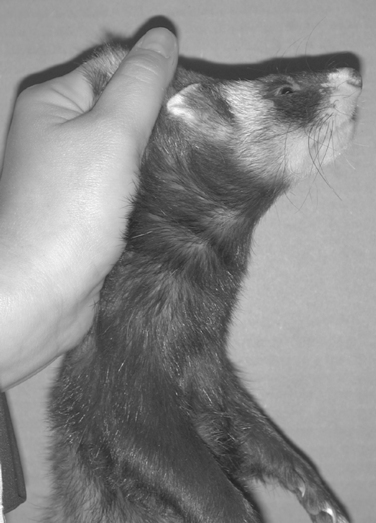Chapter 13 Overview of Ferrets, Rodents, and Rabbits
THE FERRET
The Ferret as a Patient
Most pet ferrets are accustomed to being handled and will not present a problem to the veterinarian or clinic staff; however, one should always inquire about the animal’s temperament before the examination. Ferrets will bite without warning, unlike most dogs and cats. They may be scruffed by the loose skin on the neck and suspended with all four legs off the ground (Fig. 13-1), or they may be restrained much like a cat on the table for routine procedures. If the procedure might be painful (e.g., drawing blood), the ferret should be scruffed and held at the hips. All ferrets should be vaccinated against rabies and canine distemper (IMRAB 3 [Merial] and Fervac-D [United Vaccines] or PureVax [Merial]). Anaphylactic vaccine reactions are not uncommon in ferrets, especially from the distemper vaccine, and diphenhydramine, epinephrine, or corticosteroids should be used if a reaction occurs.
RODENTS
Rats and Mice
Mice, and especially domesticated rats, make good pets; however, they may produce severe allergic reactions in some people. Because of their resemblance to the wild pest species, many people shy away from handling rats and mice. These pets have a limited life span, which may present a problem for the owners. Rats may live 2 to 3 years and mice an even shorter time. The best diet for pet rats is a laboratory chow designed specifically for rats, together with limited amounts of grains, vegetables, and fruits. Owners typically overfeed rats on junk food, resulting in obese, obnoxious pets that beg for food. Rats can be housed in a variety of cages, some with condos and luxury furniture for the comfort of the occupant. Whatever type of cage is used, it must have good ventilation because rats urinate frequently and the ammonia build-up in poorly ventilated cages can affect the health of the animal. Rats respond well at normal room temperatures, but should not be left to roam the house unattended.
Stay updated, free articles. Join our Telegram channel

Full access? Get Clinical Tree



